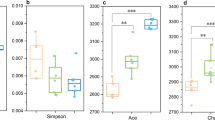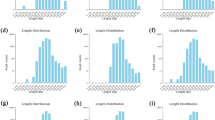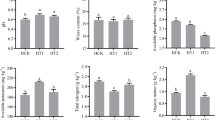Abstract
The effects of the short-term application of Ascophyllum nodosum-fermented seaweed fertilizer on the bacterial community, soil nitrogen contents, and plant growth in maize rhizosphere soil were evaluated. The changes in the bacterial community composition and nitrogen contents including those of total nitrogen (TN), nitrate nitrogen (NO3−-N) and ammonium nitrogen (NH4+-N) in rhizosphere soils in response to treatment with seaweed fertilizer were determined. Furthermore, soil enzymatic activity and crop biomass were analyzed. The relative abundance of the dominant phyla varied regularly with fertilization, and bacterial α-diversity was apparently influenced by seaweed fertilizer amendment. The TN contents of all soil samples decreased gradually, and the NO3−-N and NH4+-N contents of the soils treated with seaweed fertilizer were much higher than those of the control soils. Similarly, the enzymatic activities of dehydrogenase, nitrite reductase, urease, and cellulase in the soil were significantly increased on day 3, day 8, and day 13 after the application of seaweed fertilizer to the maize rhizosphere soil. However, there was no difference in the activity of soil sucrase between the treatment group and the control group. In this study, the growth of maize seedlings was confirmed to be greatly promoted by the utilization of seaweed fertilizer. These results deepen our understanding of plant-microbe interactions in agroecosystems and should benefit the wide use of seaweed fertilizer in sustainable agricultural production.








Similar content being viewed by others
References
Ajwa HA, Dell CJ, Rice CW (1999) Changes in enzyme activities and microbial biomass of tallgrass prairie soil as related to burning and nitrogen fertilization. Soil Biol Biochem 31:769–777. https://doi.org/10.1016/S0038-0717(98)00177-1
An Y-J, Kim M (2009) Effect of antimony on the microbial growth and the activities of soil enzymes. Chemosphere 74:654–659. https://doi.org/10.1016/j.chemosphere.2008.10.023
Atafar Z, Mesdaghinia A, Nouri J, Homaee M, Yunesian M, Ahmadimoghaddam M, Mahvi AH (2010) Effect of fertilizer application on soil heavy metal concentration. Environ Monit Assess 160:83–89. https://doi.org/10.1007/s10661-008-0659-x
Bankdick AK, Dick RP (1999) Field management effects on soil enzyme activities. Soil Biol Biochem 31:1471–1479. https://doi.org/10.1016/S0038-0717(99)00051-6
Bray JR, Curtis JT (1957) An ordination of the upland forest communities of southern Wisconsin. Ecol Monogr 27(4):325–349
Caldwell BA (2005) Enzyme activities as a component of soil biodiversity: a review. Pedobiologia 49:637–644. https://doi.org/10.1016/j.pedobi.2005.06.003
Casida LCJR, Klein DA, Santoro T (1964) Soil dehydrogenase activity. Soil Sci 98:371–376
Dinnes DL, Karlen DL, Jaynes DB, Kaspar TC, Hatfield JL, Colvin TS, Cambardella CA (2002) Nitrogen management strategies to reduce nitrate leaching in tile-drained midwestern soils. Agron J 94:153–171. https://doi.org/10.2134/agronj2002.1530
Fischer G, Winiwarter W, Ermolieva T, Cao GY, Qui H, Klimont Z, Wiberg D, Wagner F (2010) Integrated modeling framework for assessment and mitigation of nitrogen pollution from agriculture: concept and case study for China. Agric Ecosyst Environ 136:116–124. https://doi.org/10.1016/j.agee.2009.12.004
Frankenberger WT Jr, Dick WA (1983) Relationships between enzyme activities and microbial growth and activity indices in soil. Soil Sci Soc Am J 47:945–951. https://doi.org/10.2136/sssaj1983.03615995004700050021x
García-Ruiz R, Ochoa V, Hinojosa MB, Hinojosa MB, Carreira JA (2008) Suitability of enzyme activities for the monitoring of soil quality improvement in organic agricultural systems. Soil Biol Biochem 40:2137–2145. https://doi.org/10.1016/j.soilbio.2008.03.023
Ge GF, Li ZJ, Zhang J, Wang LG, Xu MG, Zhang JB, Wang JK, Xie XL, Liang YC (2009) Geographical and climatic differences in long-term effect of organic and inorganic amendments on soil enzymatic activities and respiration in field experimental stations of China. Ecol Complex 6:421–431. https://doi.org/10.1016/j.ecocom.2009.02.001
Guo JH, Liu XJ, Zhang Y, Shen JL, Han WX, Zhang WF, Christie P, Goulding KWT, Vitousek PM, Zhang FS (2010) Significant acidification in major Chinese croplands. Sci 327:1008–1010. https://doi.org/10.1126/science.1182570
Hauke J, Kossowski T (2011) Comparison of values of Pearson’s and Spearman’s correlation coefficients on the same sets of data. Quaest Geogr 30:87–93
Jayaraj J, Wan A, Rahman M, Punja ZK (2008) Seaweed extract reduces foliar fungal diseases on carrot. Crop Prot 27:1360–1366. https://doi.org/10.1016/j.cropro.2008.05.005
Khan W, Rayirath UP, Subramanian S, Jithesh MN, Rayorath P, Hodges DM, Critchley AT, Craigie JS, Norrie J, Prithiviraj B (2009) Seaweed extracts as biostimulants of plant growth and development. J Plant Growth Regul 28:386–399. https://doi.org/10.1007/s00344-009-9103-x
Kotroczó Z, Veres Z, Fekete I, Krakomperger Z, Tóth JA, Lajtha K, Tóthmérész B (2014) Soil enzyme activity in response to long-term organic matter manipulation. Soil Biol Biochem 70:237–243. https://doi.org/10.1016/j.soilbio.2013.12.028
Kumar NA, Vanlalzarzova B, Sridhar S, Baluswami M (2012) Effect of liquid seaweed fertilizer of Sargassum wightii Grev. on the growth and biochemical content of green gram (Vigna radiate (L.) R. Wilczek). Recent Res Sci Technol 4:40–45
Langille MGI, Zaneveld J, Caporaso JG, McDonald D, Knights D, Reyes JA, Clemente JC, Burkepile DE, Thurber RLV, Knight R, Beiko RG, Huttenhower C (2013) Predictive functional profiling of microbial communities using 16S rRNA marker gene sequences. Nat Biotechnol 31:814–821. https://doi.org/10.1038/nbt.2676
Latique S, Chernane H, Mansori M, Kaoua E (2013) Seaweed liquid fertilizer effect on physiological and biochemical parameters of bean plant (Phaesolus vul-garis var Paulista) under hydroponic system. Eur Sci J 9:174–193
Liu F, Ying GG, Tao R, Zhao JL, Yang JF, Zhao LF (2009) Effects of six selected antibiotics on plant growth and soil microbial and enzymatic activities. Environ Pollut 157:1636–1642. https://doi.org/10.1016/j.envpol.2008.12.021
Lötze E, Hoffman EW (2016) Nutrient composition and content of various biological active compounds of three South African-based commercial seaweed biostimulants. J Appl Phycol 28:1379–1386. https://doi.org/10.1007/s10811-015-0644-z
Lu JR, Domingo JS (2008) Turkey fecal microbial community structure and functional gene diversity revealed by 16S rRNA gene and metagenomic sequences. J Microbiol 46:469–477. https://doi.org/10.1007/s12275-008-0117-z
Makoi JHJR, Ndakidemi PA (2008) Selected soil enzymes: examples of their potential roles in the ecosystem. Afr J Biotechnol 7:181–191. https://doi.org/10.5897/AJB07.590
Marx MC, Wood M, Jarvis SC (2001) A microplate fluorimetric assay for the study of enzyme diversity in soils. Soil Biol Biochem 33:1633–1640. https://doi.org/10.1016/S0038-0717(01)00079-7
Munshaw GC, Ervin EH, Shang C, Askew SD, Zhang X, Lemus RW (2006) Influence of late-season iron, nitrogen, and seaweed extract on fall color retention and cold tolerance of four Bermudagrass cultivars. Crop Sci 46:273–283. https://doi.org/10.2135/cropsci2005.0078
Nannipieri P, Giagnoni L, Renella G, Puglisi E, Ceccanti B, Masciandaro G, Fornasier F, Moscatelli MC, Marinari S (2012) Soil enzymology: classical and molecular approaches. Biol Fertil Soils 48:743–762. https://doi.org/10.1007/s00374-012-0723-0
Rathore SS, Chaudhary DR, Boricha GN, Ghosh A, Bhatt BP, Zodape ST, Patolia JS (2009) Effect of seaweed extract on the growth, yield and nutrient uptake of soybean (Glycine max) under rainfed conditions. S Afr J Bot 75:351–355. https://doi.org/10.1016/j.sajb.2008.10.009
Rondon MR, August PR, Bettermann AD, Brady SF, Grossman TH, Liles MR, Loiacono KA, Lynch BA, Macneil IA, Minor C, Tiong CL, Gilman M, Osburne MS, Clardy J, Handelsman J, Goodman RM (2000) Cloning the soil metagenome: a strategy for accessing the genetic and functional diversity of uncultured microorganisms. Appl Environ Microbiol 66:2541–2547. https://doi.org/10.1128/AEM.66.6.2541-2547.2000
Ros M, Hernandez MT, Garcia C (2003) Soil microbial activity after restoration of a semiarid soil by organic amendments. Soil Biol Biochem 35:463–469. https://doi.org/10.1016/S0038-0717(02)00298-5
Rotthauwe JH, Witzel KP, Liesack W (1997) The ammonia monooxygenase structural gene amoA as a functional marker: molecular fine-scale analysis of natural ammonia-oxidizing populations. Appl Environ Microbiol 63:4704–4712
Sangeetha V, Thevanathan R (2010) Potential of traditional and Panchagavya amended with seaweed extract. J Am Sci 6:61–67
Sardar K, Qing C, El Latif HA, Yue X, Zheng HJ (2007) Soil enzymatic activities and microbial community structure with different application rates of Cd and Pb. J Environ Sci 19:834–840. https://doi.org/10.1016/S1001-0742(07)60139-9
Shackle VJ, Freeman C, Reynolds B (2000) Carbon supply and the regulation of enzyme activity in constructed wetlands. Soil Biol Biochem 32:1935–1940. https://doi.org/10.1016/S0038-0717(00)00169-3
Simpson K, Hayes SF (1958) The effect of soil conditioners on plant growth and soil structure. J Sci Food Agric 9(3):163–170
Tay SAB, Macleod JK, Palni LMS, Letham DS (1985) Detection of cytokinins in a seaweed extract. Phytochemistry 24(11):2611–2614
Torsvik V, Øvreås L (2002) Microbial diversity and function in soil: from genes to ecosystems. Curr Opin Microbiol 5:240–245. https://doi.org/10.1016/S1369-5274(02)00324-7
Velthof GL, Oudendag D, Witzke HP, Asman WAH, Klimont Z, Oenema O (2009) Integrated assessment of nitrogen losses from agriculture in EU-27 using MITERRA-EUROPE. J Environ Qual 38:402–417. https://doi.org/10.2134/jeq2008.0108
Wang MP, Chen L, Li YT, Chen L, Liu ZY, Wang XJ, Yan PS, Qin S (2018) Responses of soil microbial communities to a short-term application of seaweed fertilizer revealed by deep amplicon sequencing. Appl Soil Ecol 125(4):288–296. https://doi.org/10.1016/j.apsoil.2018.02.013
Zhang XQ, Thomsen M (2019) Biomolecular composition and revenue explained by interactions between extrinsic factors and endogenous rhythms of Saccharina latissimi. Mar Drugs 17:107. https://doi.org/10.3390/md17020107
Zhu ZL, Chen DL (2002) Nitrogen fertilizer use in China-contributions to food production, impacts on the environment and best management strategies. Nutr Cycl Agroecosyst 63:117–127. https://doi.org/10.1023/A:1021107026067
Zhu YD, Ni HF, Cao J, Li KL, Yue QL, Zhao L (2019) A new PGA-seaweed water-retaining agent and its use in saline-alkali soils repairing. AIP Conf Proc 2110:020015. https://doi.org/10.1063/1.5110809
Zodape ST, Gupta A, Bhandari SC, Rawat US, Chaudhary DR, Eswaran K, Chikara J (2011) Foliar application of seaweed sap as biostimulants for enhancement of yield and quality of tomato (Lycopersicon esculentum Mill.). J Sci Ind Res 70:215–219
Acknowledgments
The authors appreciate the assistance of Baoyun Feng in the data processing and chart presentation.
Funding
This work was funded by the National Natural Science Foundation of China (No. 31870496) and the Open Foundation of the Ministry of Agriculture Key Laboratory of Seaweed Fertilizers (No. MAKLSF1810).
Author information
Authors and Affiliations
Corresponding author
Ethics declarations
Conflict of interest
The authors declare that they have no conflicts of interest.
Additional information
Publisher’s note
Springer Nature remains neutral with regard to jurisdictional claims in published maps and institutional affiliations.
Electronic supplementary material
Fig. S1
The predicted COG function classification based on deep 16S rRNA sequencing data using PICRUSt. (PDF 19 kb)
Fig. S2
The predicted high-abundance functional enzymes based on deep 16S rRNA sequencing data using PICRUSt. COG1028, Dehydrogenase reductase; COG1309, Transcriptional regulator; COG2814, Major facilitator; COG0624, Histidine kinase; COG1595, RNA polymerase; COG0596, Alpha beta hydrolase; COG0745, Regulator; COG0438, Glycosyl transferase (Group 1); COG0583, Transcriptional regulator; COG2197, Two-component transcriptional regulator, luxR family; COG0515, Serine threonine protein kinase; COG2226, Methyltransferase required for the conversion of demethylmenaquinone to menaquinone; COG1960, acyl-CoA dehydrogenase; COG2204, Two-component sigma54-specific, transcriptional regulator, Fis family; COG1846, Transcriptional regulator. (PDF 15 kb)
Rights and permissions
About this article
Cite this article
Chen, Y., Li, J., Huang, Z. et al. Impact of short-term application of seaweed fertilizer on bacterial diversity and community structure, soil nitrogen contents, and plant growth in maize rhizosphere soil. Folia Microbiol 65, 591–603 (2020). https://doi.org/10.1007/s12223-019-00766-4
Received:
Accepted:
Published:
Issue Date:
DOI: https://doi.org/10.1007/s12223-019-00766-4




